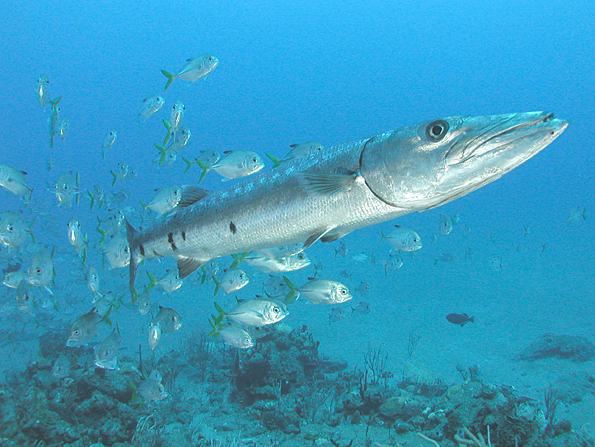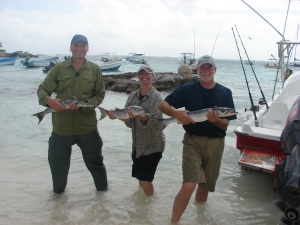“Oh my God, he doesn’t see it…” Susan was saying to herself.
The thing about snorkeling is that you’re always looking down, instead of forward. But then I was twenty seconds away from learning several things about snorkeling that I hadn’t really thought much about before.
“Oh my God, he still doesn’t see it…” Susan said to herself.
In the best of times I’m not the most observant person in the world, but when I’m absorbed in the microcosm of a coral reef ecosystem, while floating on the surface, while looking down, while moving forward—well, I’m just pretty obtuse about what’s ahead of me, even by my own standards.
“…he’s really not seeing that thing, he’s really not seeing that thing…” Susan’s brain was repeating over and over, and here’s another thing about snorkeling: you can’t call out to each other. And that’s actually a pretty up-there handicap when you’re swimming around in the midway point of a food chain. Susan was going nuts twenty feet behind me. She was trying to raise my head through psychokinesis.
What I finally saw was the creature’s shadow on the bottom, about five feet below me. I saw the shadow looming down there, said to myself, “Hmmm,” looked up (finally), and he was three feet in front of my face, a great barracuda (Sphyraena barracuda). I was staring at his left flank and he was staring at me, and a sound track was playing in my head, and it was that low, rumbling drone they always play in the sci-fi movies when a giant spaceship is crawling across the screen, and here’s another thing about snorkeling: You can’t back up. Probably most people have never realized this or thought much about it, but you can’t back up when you’re wearing swim fins. Not really. Not meaningfully.
Not nearly damned fast enough.
I’m a rational person and a science writer, so I know that our memories tend to embellish moments like this one, and I also know that the interface between the air inside my mask and the water outside of it magnifies the images I see by up to thirty-three percent depending on a few things, so this barracuda was probably not really the size of a small submarine, but it sure seemed like it at the time. Let’s just say that he was way too big. Just a hell of a lot bigger than I needed for a predatory fish to be at that moment in my life.
So after I had successfully contorted myself around so I could swim away from this thing in a forward direction, and after I’d put a safe distance between me and it, and after I’d straightened my fins back out on my feet, and after Susan had finished laughing, which is what took the longest time and required her to come to the surface and remove her snorkel so that she didn’t die, I did what I usually do after a traumatic event: I looked up a bunch of stuff about it and published it here.
I learned that it is not actually that easy to get attacked by a great barracuda, but it can happen. The saving grace of my particular encounter was that I approached him, by dumb luck, from the side, and if you are stupid or unlucky enough to approach a large barracuda as closely as I did, that’s how you want to do it. Barracudas are like rocket ships. They are very long, very fast, very powerful, they can accelerate explosively—but they can only go in a straight line. They are built this way because they are ambush predators. Actually, their particular form of ambush predation is called ram feeding. They will hang out behind fronds of fan coral like a cop behind a billboard. They will cruise slowly around, watching, and when you encounter one you can feel that watchfulness. You get a very unscientific feeling in the pit of your stomach. Our diving friend Linda calls it “getting the eyeball.” And you feel that way for a reason. They are, in fact, visual predators, and they are carefully waiting for the right instant to explode forward in a predatory charge. They have resting periods when they’re pretty zonked out and you can approach them pretty closely, as I did, but you don’t want to do it from in front, because when they get startled the first thing they do is ignite the rockets.
They are among the fastest fish in the ocean, in short bursts. They can hit somewhere between twenty-seven and thirty-six miles per hour in a charge, depending on whom you listen to, and that’s remarkably fast for a thing that is completely submerged in water. I looked at that number, and looked at their unusual body shape, and decided to swing the wheel, and take a short detour into physics.
* * * *
There are three kinds of drag that might be experienced by a body moving through the water.
Wave drag is something the shipbuilders in Liverpool can talk about over pints all night, but which barracudas don’t care about because it only affects you if you’re traveling on the surface.
Viscous drag is the friction of the fluid against the surface of the object. One way barracudas keep that in check is with a layer of slime on their skin, but there’s something else they do that I noticed right off, but which I didn’t see mentioned anywhere in the literature (though I’m sure it’s out there): They are pretty close to cylindrical in cross-section. If you need to enclose a long, skinny space, a cylinder is how you do it with the minimum of surface area. I know this because I am an ocean kayaker, and the fastest ocean kayaks are pretty much shaped like phone poles. (This is unfortunate because a phone-pole-shaped kayak has very little opinion about whether it should be right-side-up or up-side-down.)

Wasp-waisted fighter jets: It’s all about the cross-sectional area. (Soviet Su-27 Flanker) Photo by US Dept of Defense, public domain
Then there is form drag. Form drag is the slowing you get when you have to push water out of your way, but it’s also the slowing you get when it has to fill in the spaces you leave behind you. Nature, after all, abhors a vacuum, so it’s best not to be dragging one around behind you all the time. Obviously, the best way to minimize all this is to be long and skinny and tapered at your rear end, which, in fact, is how fast fish, fast submarines and fast airplanes are all built, but it gets more interesting than that. Form drag can also happen midway down your body if your shape changes and that pushing-away and filling-in thing has to happen in smaller ways amidships, so fast fish will not only be skinny, they will also be very smooth and uniform for most of their body length. But here’s something even more interesting: fast fish can get away with some shape irregularities as long as their cross-sectional area stays about the same. A few hundred million years later, aeronautical engineers figured this out also. It’s called the Whitcomb Area Rule, and it becomes increasingly important as you approach the speed of sound. It’s why fighter jets have that funny, wasp-waisted look, to keep the wings from blowing out their cross-sectional area.
* * * *
Put it all together and you have a barracuda. Or, if you’re a fresh water person, you have the northern pike (Esox lucius). It’s a body shape called fusiform, but how they use that body is also interesting. It’s a swimming style called carangiform, in which only the rear-most one third of their body flexes when they swim. The whole forward part of them stays pretty much rigid, so that there is very little side-to-side waste in their motion. They have sacrificed maneuverability for speed.
Barracuda have that sinister look because of their under-bite and those wicked-looking teeth, and it’s not just show—you genuinely don’t want to tangle with those jaws. Those jaws were ingeniously designed by some evil evolutionary forces. They have a huge gape, and they have two sets of teeth on each jaw, a row on the outside that is small, flat and razor-sharp, and right inside of it, a row of dagger-like things that plunge into sockets in the opposing jaw. The result is that the barracuda can make a flash decision to “ram” a prey fish without caring very much how big it is. The big teeth pierce the fish and hold it, and anything sticking out the sides gets neatly amputated by the row of little razor-sharp ones. Divers report them using a “three strikes” technique—they hit the fish in the middle, then return twice more for the head and the tail. They can kill prey as large as themselves.
Attacks on humans are rare, and accidental, but the thing to remember in the ocean is that accidents happen. For one thing, they will strike anything that glitters, so it’s best to leave your baubles and bangles at home. I don’t even wear my wedding ring, lest I pull a Frodo Baggins and lose both my ring and the finger it had been on. Another reason things can get messy between swimmers and barracuda is that they are also scavengers. This is true of a lot of predators we consider to be proud and noble, including the bald eagle and the wolf. Being willing to eat carrion or scavenge others’ kills will actually get you out of a lot of pinches, and few species are beyond it. So barracuda will follow large predators, hoping to grab some of the pieces if someone gets nailed, and this gives them the unnerving habit of following us around as we swim. Spear fishing among barracuda can get especially dicey.
Susan and I actually see the smaller, one- to two-foot barracudas fairly commonly when we swim around here. Like almost all the fishes in the Caribbean, the juveniles find shelter in the mangrove roots, the sea grass beds and the coral reefs—all the places Susan and I like to swim. The big adults are more about the open water.



Hi Randy. Just got back from Chapis and saw the fish story . Had to read it now and found that I could identify with it. Some years ago I had a similar encounter on Nassau Grand Bahama island. There were three of them and all looked to be 9 feet pond . As I retreated looking back nervously ,they were following at about the same distance ,30 feet or so. I exited the water at a rock jetty only to find two local spear fishermen having quite a laugh. They were watching the whole episode. They told me the fish were only 5 feet long not ten. And they won’t attack anything as big as me. And then resumed laughing again. Now I know thanks Randy always a good read
That’s a great story! Thanks, Tom!
Says my 22-year old son & fan of Gerald Durrell…”Very cool! When’s he going to publish a book?”
Thanks, Gail! So glad your son enjoyed it! It’s always heartening to hear of a young person who is connected to nature.
Randy, you paint such compelling drama that it makes it fun to keep reading and learn more.
Thanks, Marty! Hey, as my web designer, you can take some of the credit!
Hah!
Very engaging read and, as always, very informative. One might hope that from now on, you’ll be taking the occasional horizontal glance forward as you snorkel.
Keep ’em coming, and PUBLISH THE BOOK!!
Thanks, By! I’ll look into a book, honest I will!